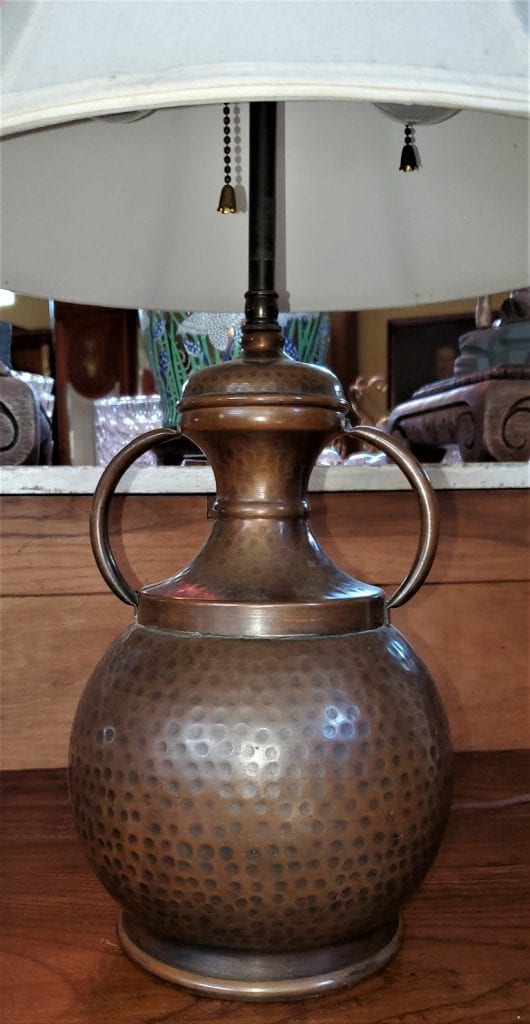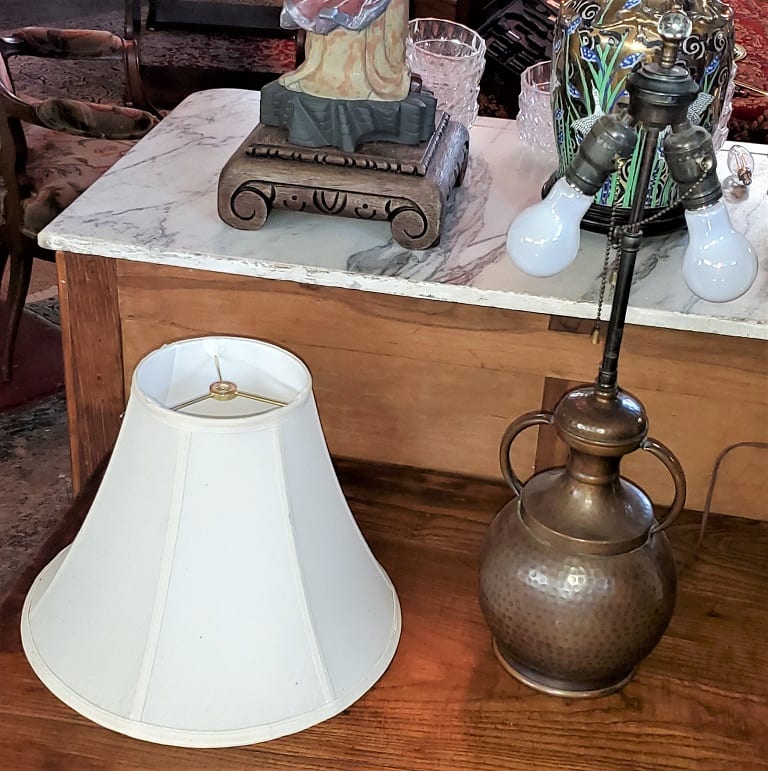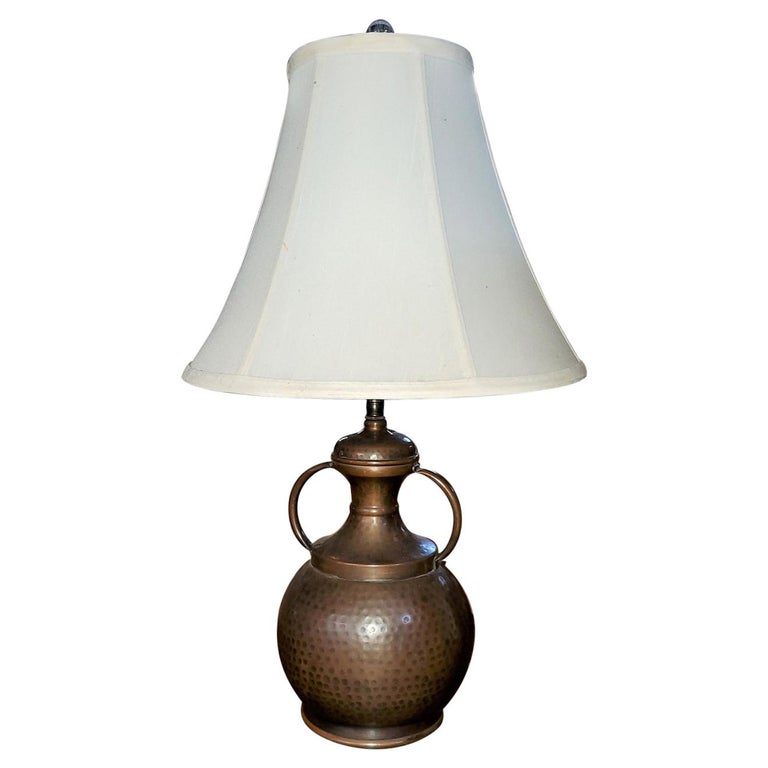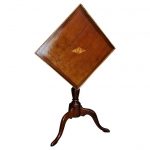Early 20C American Hand Beaten Copper Table Lamp
PRESENTING a LOVELY Early 20C American Hand Beaten Copper Table Lamp.
From circa 1900 and probably made in Connecticut.
Unmarked but of very fine quality. It is a 2 handled, hand beaten copper urn style lamp with GORGEOUS natural patina.
Very reminiscent of the Arts & Crafts work done in the UK at the end of the 19th Century by the New Lyn (Cornwall) School of craftsmen and women.
Original period hardware and fixtures with a lovely glass finial.
Extendable central column.
Nice size !
The Arts and Crafts movement was an international trend in the decorative and fine arts that developed earliest and most fully in the British Isles and subsequently spread across the British Empire and to the rest of Europe and America.
Initiated in reaction against the perceived impoverishment of the decorative arts and the conditions in which they were produced, the movement flourished in Europe and North America between about 1880 and 1920. It is the root of Modern Style (British Art Nouveau style) which it strongly influenced. In Japan it emerged in the 1920s as the Mingei movement. It stood for traditional craftsmanship, and often used medieval, romantic, or folk styles of decoration. It advocated economic and social reform and was anti-industrial in its orientation. It had a strong influence on the arts in Europe until it was displaced by Modernism in the 1930s, and its influence continued among craft makers, designers, and town planners long afterwards.
The term was first used by T. J. Cobden-Sanderson at a meeting of the Arts and Crafts Exhibition Society in 1887, although the principles and style on which it was based had been developing in England for at least 20 years. It was inspired by the ideas of architect Augustus Pugin, writer John Ruskin, and designer William Morris. In Scotland it is associated with key figures such as Charles Rennie Mackintosh.
In the United States, the Arts and Crafts style initiated a variety of attempts to reinterpret European Arts and Crafts ideals for Americans. These included the “Craftsman”-style architecture, furniture, and other decorative arts such as designs promoted by Gustav Stickley in his magazine, The Craftsman and designs produced on the Roycroft campus as publicized in Elbert Hubbard’s The Fra. Both men used their magazines as a vehicle to promote the goods produced with the Craftsman workshop in Eastwood, NY and Elbert Hubbard’s Roycroft campus in East Aurora, NY. A host of imitators of Stickley’s furniture (the designs of which are often mislabelled the “Mission Style“) included three companies established by his brothers.
The terms American Craftsman or Craftsman style are often used to denote the style of architecture, interior design, and decorative arts that prevailed between the dominant eras of Art Nouveau and Art Deco in the US, or approximately the period from 1910 to 1925. The movement was particularly notable for the professional opportunities it opened up for women as artisans, designers and entrepreneurs who founded and ran, or were employed by, such successful enterprises as the Kalo Shops, Pewabic Pottery, Rookwood Pottery, and Tiffany Studios. In Canada, the term Arts and Crafts predominates, but Craftsman is also recognized.
While the Europeans tried to recreate the virtuous crafts being replaced by industrialisation, Americans tried to establish a new type of virtue to replace heroic craft production: well-decorated middle-class homes. They claimed that the simple but refined aesthetics of Arts and Crafts decorative arts would ennoble the new experience of industrial consumerism, making individuals more rational and society more harmonious. The American Arts and Crafts movement was the aesthetic counterpart of its contemporary political philosophy, progressivism. Characteristically, when the Arts and Crafts Society began in October 1897 in Chicago, it was at Hull House, one of the first American settlement houses for social reform.
Arts and Crafts ideals disseminated in America through journal and newspaper writing were supplemented by societies that sponsored lectures. The first was organized in Boston in the late 1890s, when a group of influential architects, designers, and educators determined to bring to America the design reforms begun in Britain by William Morris; they met to organize an exhibition of contemporary craft objects. The first meeting was held on January 4, 1897, at the Museum of Fine Arts (MFA) in Boston to organize an exhibition of contemporary crafts. When craftsmen, consumers, and manufacturers realised the aesthetic and technical potential of the applied arts, the process of design reform in Boston started. Present at this meeting were General Charles Loring, Chairman of the Trustees of the MFA; William Sturgis Bigelow and Denman Ross, collectors, writers and MFA trustees; Ross Turner, painter; Sylvester Baxter, art critic for the Boston Transcript; Howard Baker, A.W. Longfellow Jr.; and Ralph Clipson Sturgis, architect.
The first American Arts and Crafts Exhibition began on April 5, 1897, at Copley Hall, Boston featuring more than 1000 objects made by 160 craftsmen, half of whom were women. Some of the advocates of the exhibit were Langford Warren, founder of Harvard’s School of Architecture; Mrs. Richard Morris Hunt; Arthur Astor Carey and Edwin Mead, social reformers; and Will H. Bradley, graphic designer. The success of this exhibition resulted in the incorporation of The Society of Arts and Crafts (SAC), on June 28, 1897, with a mandate to “develop and encourage higher standards in the handicrafts.” The 21 founders claimed to be interested in more than sales, and emphasized encouragement of artists to produce work with the best quality of workmanship and design. This mandate was soon expanded into a credo, possibly written by the SAC’s first president, Charles Eliot Norton, which read:
This Society was incorporated for the purpose of promoting artistic work in all branches of handicraft. It hopes to bring Designers and Workmen into mutually helpful relations, and to encourage workmen to execute designs of their own. It endeavors to stimulate in workmen an appreciation of the dignity and value of good design; to counteract the popular impatience of Law and Form, and the desire for over-ornamentation and specious originality. It will insist upon the necessity of sobriety and restraint, or ordered arrangement, of due regard for the relation between the form of an object and its use, and of harmony and fitness in the decoration put upon it.
Built in 1913-14 by the Boston architect J. Williams Beal in the Ossipee Mountains of New Hampshire, Tom and Olive Plant’s mountaintop estate, Castle in the Clouds also known as Lucknow, is an excellent example of the American Craftsman style in New England.
Also influential were the Roycroft community initiated by Elbert Hubbard in Buffalo and East Aurora, New York, Joseph Marbella, utopian communities like Byrdcliffe Colony in Woodstock, New York, and Rose Valley, Pennsylvania, developments such as Mountain Lakes, New Jersey, featuring clusters of bungalow and chateau homes built by Herbert J. Hapgood, and the contemporary studio craft style. Studio pottery—exemplified by the Grueby Faience Company, Newcomb Pottery in New Orleans, Marblehead Pottery, Teco pottery, Overbeck and Rookwood pottery and Mary Chase Perry Stratton‘s Pewabic Pottery in Detroit, the Van Briggle Pottery company in Colorado Springs, Colorado, as well as the art tiles made by Ernest A. Batchelder in Pasadena, California, and idiosyncratic furniture of Charles Rohlfs all demonstrate the influence of Arts and Crafts.
Link: https://en.wikipedia.org/wiki/Arts_and_Crafts_movement
Early 20C American Hand Beaten Copper Table Lamp.
Provenance: From an Outstanding Private Dallas Collection.
Condition: Very good.
Dimensions: 24 inches Tall with a base diameter of 7 inches.
SALE PRICE NOW: $1,000

























